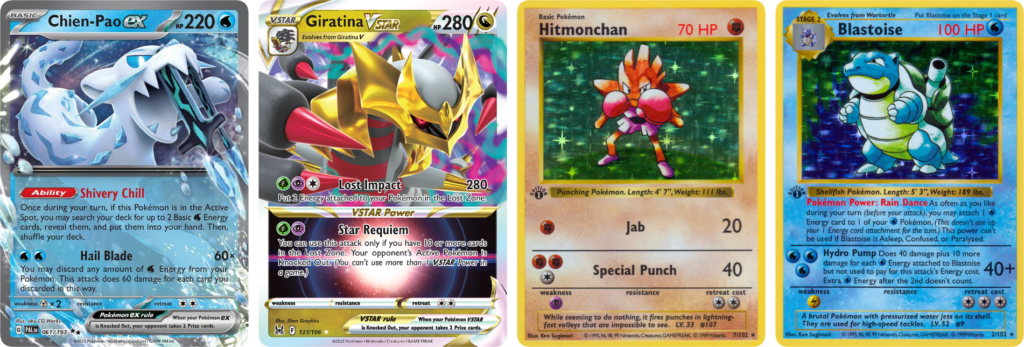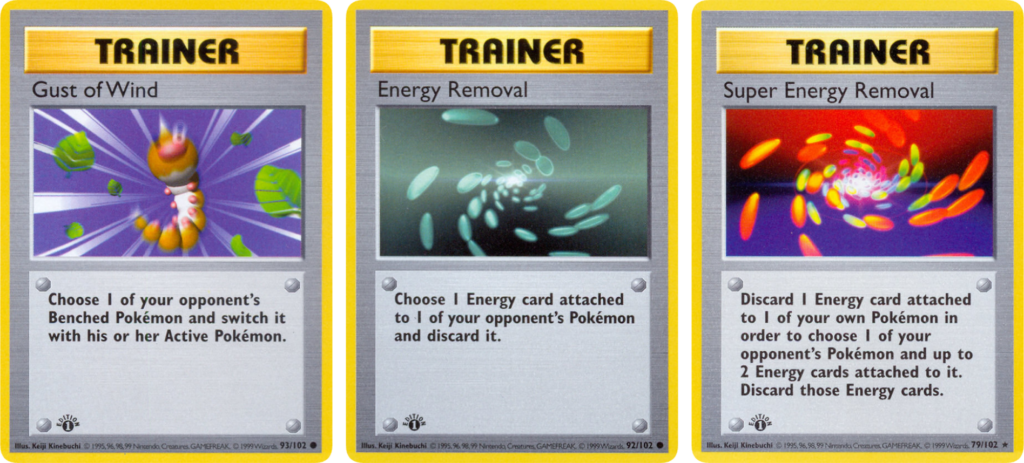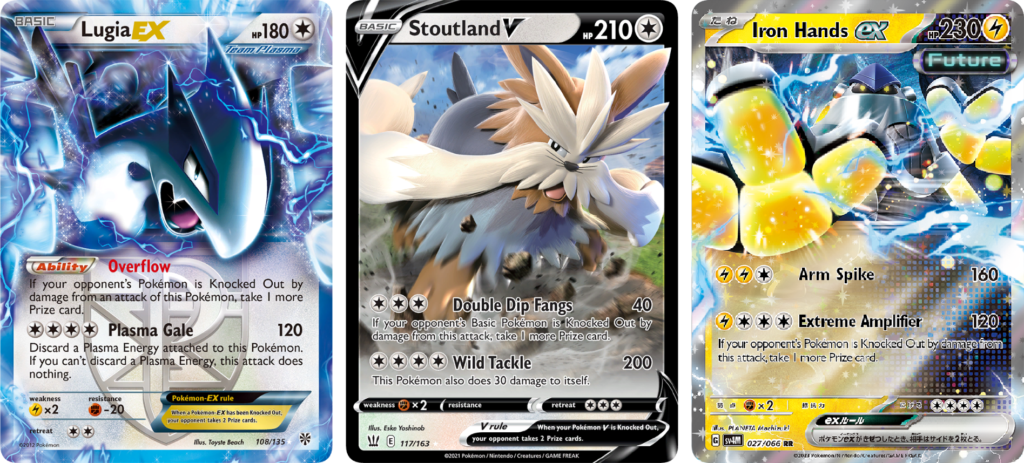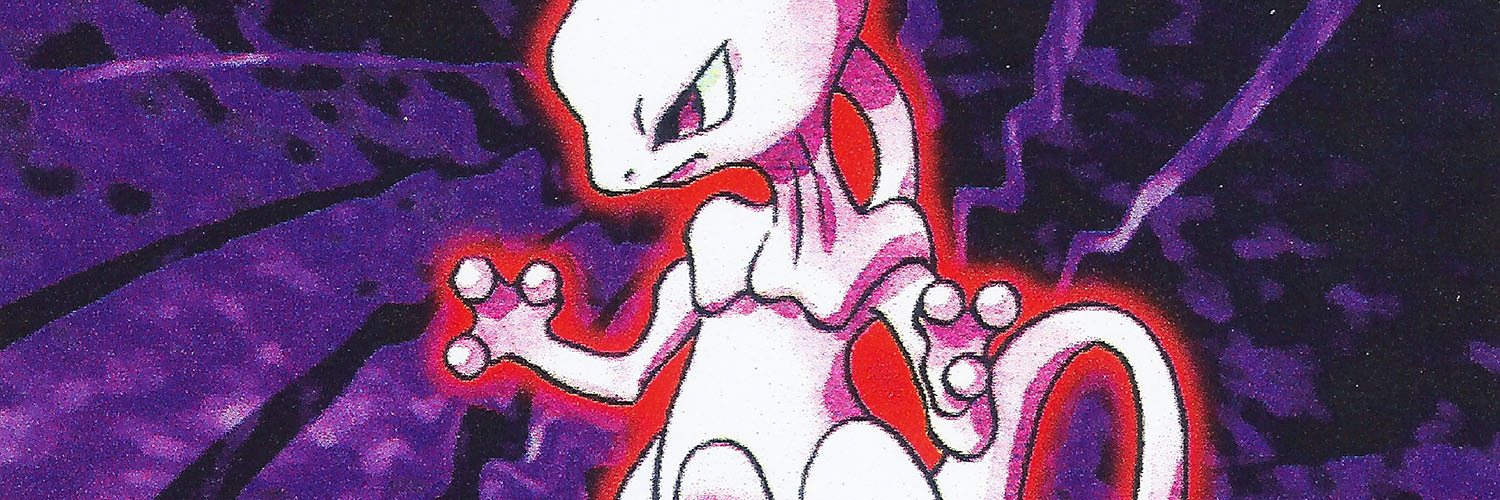Power creep: A term often thrown around in discussions of card game design. Broadly, it describes the phenomenon of cards becoming gradually more ‘powerful’ over long periods of time. In my view, the way most people talk about power creep is superficial. Discussions I’ve seen only focus on the surface and elude anything worth being concerned over from a player’s perspective. What I’ll be exploring throughout this article is where the substance lies: relative power creep, and its many manifestations.
1. Power Creep in HP
The easiest way to observe power creep in the Pokémon TCG is by observing the HP of cards over time. As an example, let’s look at the progression of regular single-prize Mewtwo cards.

These are all of the mechanically unique regular Mewtwo cards from Base Set up until Scarlet & Violet 151 (this excludes reprints, multi-prize Mewtwo cards and specially named cards like Rocket’s Mewtwo).
Mewtwo debuted in Base Set with 60ʜᴘ, and was printed with either 60ʜᴘ or 70ʜᴘ up until its first print in the Diamond & Pearl era. This card from Majestic Dawn (first card pictured on the second row) jumped to 90ʜᴘ, and the following two cards from the Diamond & Pearl era had it at 80ʜᴘ and 100ʜᴘ respectively. Mewtwo didn’t have a card from the Heart Gold & Soul Silver era, and the next time it was featured was during the end of the Black & White era. Here we see a jump to 120ʜᴘ, which is shared by its next print as an XY Promo card. In the Evolutions Set, Mewtwo is given 130ʜᴘ— that’s more than double its HP in the original Base Set print that the Evolutions Mewtwo is a spiritual reprint of. Throughout the Sun & Moon era, Mewtwo is either featured with 120ʜᴘ or 130ʜᴘ, and the three cards from the Sword & Shield era to Scarlet & Violet 151 give Mewtwo 130ʜᴘ.
An important thing to pinpoint in this progression is when exactly HP jumps took place. Most power increases take place at the start of a new generation, and this is reflected in Mewtwo’s jump from 70ʜᴘ to 90ʜᴘ in the Diamond & Pearl era, and its jump from 100ʜᴘ to 120ʜᴘ in the Black & White era. This trend of power-increases each generation is shared among most Pokémon, as you’ll see in examples later. But for now we should ask, how exactly is this information useful to players?
The short answer is that it isn’t very useful at all. The only takeaway of note is that, while you’re looking at results many years in the past, you should remember vaguely to adjust your expectations of what a good card looks like. 70ʜᴘ back in Base Set was much better of a number than 70ʜᴘ is today. This is the essence of almost all discussions on power creep, and the reason why those discussions are superficial. They make sense in other card games with an Unlimited format where you can use cards from many years prior. However in Pokémon, we’re limited to the previous three years worth of cards in the Standard format, so the effects of long-term power creep like this are often inconsequential. There’s no meaningful difference between playing with 100ʜᴘ Pokémon that 2HKO each other and 300ʜᴘ Pokémon that 2HKO each other. The only time you’ll notice cards on the whole becoming more powerful is at the start of a new generation. As I mentioned before, the substance lies in relative power creep, and we’ll need to take a look at more cards to define what that means.

These are all the mechanically unique regular Blastoise cards from Base Set up until Scarlet & Violet 151.
Blastoise debuted in Base Set with 100ʜᴘ and stayed at that number throughout the first two generations. During the Ruby & Sapphire era, Blastoise’s HP had a slight increase to 110ʜᴘ and 120ʜᴘ. And a similar increase occurred during the Diamond & Pearl era where Blastoise was featured with 120ʜᴘ and 130ʜᴘ, and Heart Gold & Soul Silver kept it at 130ʜᴘ. Black & White’s Boundaries Crossed saw an increase to 140ʜᴘ, and Blastoise wasn’t printed during the X&Y era. When it returned in the Sun & Moon era it had 160ʜᴘ, and finally Sword & Shield increased it to 170ʜᴘ.
Note the difference in the HP increase from Mewtwo and Blastoise— while Mewtwo’s HP more than doubled with a 116% increase from 60ʜᴘ to 130ʜᴘ, Blastoise’s HP only increased by 70% from 100ʜᴘ to 170ʜᴘ. Over the years, regular Mewtwo cards have become stronger relative to Blastoise cards— this is what I mean by relative power creep. In general, regular Basic Pokémon that are fully-evolved (i.e. don’t have any evolutions) seem to be increasing in power at a faster rate than other regular Pokémon. Some more evidence of this can be found by comparing the progression of the classic Haymaker duo: Hitmonchan and Electabuzz.

These are all the mechanically unique regular Hitmonchan and Electabuzz cards from Base Set up until Scarlet & Violet 151.
Hitmonchan and Electabuzz both debuted in Base Set with 70ʜᴘ, and each had their lowest-HP cards printed in the Gold & Silver era at 60ʜᴘ. Now looking today, Electabuzz’s print in Scarlet & Violet 151 has 90ʜᴘ, and Hitmonchan’s has 120ʜᴘ. Electabuzz’s HP has increased only 50% from its lowest 60ʜᴘ to 90ʜᴘ, while Hitmonchan’s has increased by 100% from 60ʜᴘ to 120ʜᴘ. While both Pokémon started as fully-evolved in the first generation, Electabuzz received an evolution in Electivire during the fourth generation, effectively stunting its power creep. While the greater relative power creep of regular full-evolved Basic Pokémon is significant, that difference is benign compared to what’s happened with two-prize Pokémon: 𝙚𝙭s, 𝙀𝙓s, 𝙂𝙓s, 𝙑s, and Ҽ𝙓s.

These are all the mechanically unique two-prize Mewtwo cards from Base Set up until Paradox Rift.
Mewtwo 𝙚𝙭 debuted in Ruby & Sapphire with 100ʜᴘ. Nine years later, Mewtwo 𝙀𝙓 was printed with 170ʜᴘ, which was the same number used by two Mewtwo 𝙀𝙓s from the X&Y era. The Mewtwo 𝙀𝙓 from the Evolutions set had 180ʜᴘ, and the Mewtwo 𝙂𝙓s from the Sun & Moon era all either had 180ʜᴘ or 190ʜᴘ. Mewtwo 𝙑 from the Sword & Shield era jumps to 220ʜᴘ, and Mewtwo Ҽ𝙓 from Paradox Rift in the Scarlet & Violet era increases to 230ʜᴘ. That’s an astonishing 130% increase just since the Ruby & Sapphire era, where regular Mewtwo cards have only increased by 85.7% since then. And if we just look at Black & White onwards, regular Mewtwo cards increased by 8.3% while 2-prize Mewtwo cards have increased 35.3%.
We can also compare the difference between a 2-prize card and the regular counterparts in its respective era. The original Mewtwo 𝙚𝙭 with 100ʜᴘ had 42.8% higher HP than regular Mewtwo cards of the time which all had 70ʜᴘ. Mewtwo 𝙀𝙓 from the Black & White era has 41.6% more HP than regular Mewtwo. So it turns out, when compared to their regular counterparts, Black & White 𝙀𝙓s aren’t so different in power-level from the original 𝙚𝙭s. The power increase comes solely from the general trend of fully-evolved Basics getting more powerful. Mewtwo 𝙑 from the Sword & Shield era, however, has 69.2% more HP than regular Mewtwo, and Mewtwo Ҽ𝙓 from the Scarlet & Violet era has 76.9% more HP. That’s a major difference, and I’ll cover the very noticeable consequences of this difference later.
The last thing to cover on the topic of HP is analyzing the difference in HP across entire evolution lines. Gardevoir is the best example for this because of its numerous successful one-prize and two-prize cards throughout the game’s history.

- During the Ruby & Sapphire era, the highest HP on Ralts cards was 50ʜᴘ, Kirlias had 70ʜᴘ, regular Gardevoir had 100ʜᴘ, and both Gardevoir 𝙚𝙭s had 150ʜᴘ. That’s a 40% increase in HP from Ralts to Kirlia, and from Kirlia to Gardevoir. Then, a 50% increase from regular Gardevoir to Gardevoir 𝙚𝙭.
- During the Sun & Moon era, the highest HP on Ralts cards was 60ʜᴘ, Kirlias had 80ʜᴘ, regular Gardevoir had 130ʜᴘ, and Gardevoir 𝙂𝙓 had 230ʜᴘ. That’s a 33.3% increase from Ralts to Kirlia, a 62.5% increase from Kirlia to regular Gardevoir, and a 76.9% increase from regular Gardevoir to Gardevoir 𝙂𝙓.
- In the Sword & Shield to early Scarlet & Violet era, the highest HP on Ralts cards is 70ʜᴘ, Kirlias have 80ʜᴘ, regular Gardevoir has 140ʜᴘ, and Gardevoir Ҽ𝙓 has 310ʜᴘ. That’s a 14.3% increase from Ralts to Kirlia, a 75% increase from Kirlia to regular Gardevoir, and a 121.4% increase from regular Gardevoir to Gardevoir Ҽ𝙓.
As the numbers show, this is more evidence that the disparity between the HP of fully-evolved Pokémon and pre-evolved Pokémon has been growing substantially, just like the example of Hitmonchan and Electabuzz demonstrated before.
But what does this really mean practically? Percentages can be useful for viewing these disparities precisely, but there’s a more intuitive way to view these differences:
- During the Ruby & Sapphire era, knocking out 1 Gardevoir 𝙚𝙭 is equivalent in damage to knocking out 3 Ralts (50 × 3 = 150). And the lowest damage attack that 2HKOs Gardevoir 𝙚𝙭 (80 damage) does not 1HKO regular Gardevoir.
- In the Sun & Moon era, knocking out 1 Gardevoir 𝙂𝙓 is equivalent in damage to knocking out nearly 4 Ralts (60 × 4 = 240). And the lowest damage attack that 2HKOs Gardevoir 𝙂𝙓 (120 damage) does not 1HKO regular Gardevoir.
- In the current era, knocking out 1 Gardevoir Ҽ𝙓 is equivalent in damage to knocking out about 4.5 Ralts (70 × 4.5 = 315) or about 4 Kirlias (80 × 4 = 320). And the lowest damage attack that 2HKOs Gardevoir Ҽ𝙓 (160 damage) does 1HKO regular Gardevoir.
2. Power Creep in Attacks
Evaluating the relative power-level of a certain HP number is nothing without considering attack damage in tandem. If a card has 120ʜᴘ, that could be high or low, good or bad, all depending on how much damage attacks are doing. The simplest way to categorize attack damage is to break it down into how many repetitions of that attack would it take to knock out popular Pokémon in a format— is an attack 1HKO-ing, 2HKO-ing, etc.
If we look at the current Standard format as of September 2023, almost all decks have a way to OHKO multiple two-prize Pokémon in a game, and they all can easily OHKO fully-evolved one-prize Pokémon (or are based around multi-target attacks that can knock out Pokémon before they’re fully-evolved). Compare that to Base Set, where the most powerful attackers weren’t ever 1HKO-ing each other, and many struggled to even 2HKO, which made games significantly slower to the point where deck-out was a common win-condition.

Damage is always tied to a cost of use— that includes an attack’s energy cost, the cost to get the Pokémon that’s attacking into play, and how many turns will the attacker survive before it needs to be replaced. In the case of the current Standard format, Energy acceleration is more varied and prevalent than it’s ever been in the history of the game, and draw power is at such an extreme that setting up otherwise costly attackers is relatively easy. Meanwhile, in the early days of the Pokémon TCG, cards like Gust of Wind and the duo of Energy Removal cards made attackers with attack costs that would be reasonable in most formats a relative pipe-dream to use then.

Another important way to analyze attacks is by looking at how many prize cards a certain amount of cost is going to yield. An attack like Giratina 𝙑sᴛᴀʀ‘s Lost Impact is fairly expensive, so if it were regularly only yielding one prize card per attack it wouldn’t be worth using in repetition. But in the current Standard format, Giratina 𝙑sᴛᴀʀ-based decks are positioned to be able to use Lost Impact to take OHKOs on two-prize Pokémon frequently.

The intended target of an attack is also important for judging its power. Lugia 𝙀𝙓, Stoutland 𝙑, and Iron Hands Ҽ𝙓 do a moderate amount of damage and take extra prize cards. If you look at overall trends in power creep, Lugia 𝙀𝙓 seems the strongest out of the three by far because HP was lower in the past, until you recognize where all three cards intend to be attacking into: one-prize Pokémon. As we saw before, their HP hasn’t changed much at all since the Black & White era. Just because Stoutland 𝙑 (even with Powerful Colorless Energies) and Iron Hands Ҽ𝙓 aren’t getting anywhere near to the HP of two-prize Pokémon like Lugia 𝙀𝙓 could get closer to, it doesn’t mean they’re significantly weaker. As long as they’re eclipsing the HP numbers of their targets, they serve the same purpose. The power of card-draw and Energy acceleration to fuel these expensive attacks is what determines their viability, not the attack effect’s power on its own.
As a final note on attack damage power creep: while almost everything related to power creep is only worth discussing when talking about relative power creep, there is one worthwhile thing to mention. The math in the game is getting more complicated. While it’s true that as the numbers get larger, it becomes more difficult to calculate attack damage and place damage counters, there is an added flexibility from the perspective of the game designers. Attack damage can be made more precise so that it 1HKOs one Pokémon, but is barely out of range of another. It also opens up for more useful multipliers in attack damage. Attacks that do damage based on multiples of 30, 40, 50, and 60, all coexist now, and the potential for larger numbers exists.
3. Power Creep in Draw Power & Energy Acceleration
In card games without a rotating Standard format, power creep is an irreversible issue. In order for the game to avoid stagnation, game designers want new cards to replace old ones in decks. They can either print cards on the same power-level with more complicated and niche effects with restrictions, or simply make new cards more powerful than the old ones. Once the latter has been done, any newer cards that are meant to compete with a power-crept card have to be power-crept themselves.
Rotating Standard formats can evade this issue because older cards are forced out of use by a rotation. If the game designers desire, they can simply wait until a powerful card leaves the format before implementing new ideas. But Pokémon’s game designers are impatient, and to a large extent players are as well. They want a consistent stream of new archetypes that beat out older ones, so they make newer cards slightly more powerful than older ones. But this is really only the case with Pokémon designed to be attackers, not Trainer or Energy cards, and not support Pokémon.

The design team seems to be content with only one or two Supporter engines dominating the format for years on end, and with supporting effects like Rain Dance coming and going. Generally, when draw power and energy acceleration become more powerful and common, cards which require delivering high value for a high cost become more powerful. Like I mentioned before with Lugia 𝙀𝙓, Stoutland 𝙑, and Iron Hands Ҽ𝙓, just looking at the attack effect’s power isn’t enough to determine their viability.

When we look at the cards that surround Lugia 𝙀𝙓, we see comparable energy acceleration effects to today from Eelektrik’s Dynamotor, Blastoise’s Deluge, Emboar’s Inferno Fandango, and Colress Machine, but the Pokémon-based draw power is far weaker. In addition to Lugia 𝙀𝙓’s attack requiring a Plasma Energy to be attached, it takes longer to get the rest of the Energy attached than with Stoutland 𝙑, and Iron Hands Ҽ𝙓, which can realistically attack on turn two. So the decrease in power-level in terms of damage is more than made up for by the ease of setting them up.
4. Consequences of Power Creep
Among the previous anecdotes of consequences I’ve mentioned so far, there are a few major ramifications of the increasing disparity between the stats of fully-evolved Pokémon, two-prize Pokémon, and pre-evolved Pokémon.

Universal spread attacks that hit all Pokémon regardless of their stage and characteristics are now difficult to make viable and not game-breaking at the same time. During the Sun & Moon era, we saw spread attacks like Tapu Koko’s Flying Flip and Weezing’s Splattering Sludge have enormous success, but these effects have dropped off since the Sword & Shield era for good reason.
Take a deck filled with Big Basics like Miraidon Ҽ𝙓. In order to design a spread-based deck that’s competitive with this deck, the deck would need to be capable of putting and fully utilizing 600-660 damage in around five turns which could KO three two-prize Pokémon with 200-220ʜᴘ. This is spreading 120-130 damage each turn and getting it on three targets to KO. Now pair whatever balanced spread deck you have against a deck with regular Pokémon, especially Pokémon that need to evolve. Whatever solution was balanced around the two-prizers is going to vastly overpower this matchup in most circumstances.
The larger issue is when it comes to why spread decks were powerful at all during the Sun & Moon era: Tapu Lele’s Magical Swap. Tapu Koko’s and Weezing’s attacks were balanced around the power-level of regular Pokémon, not the 𝙂𝙓s of the era, so they wouldn’t be strong on their own. Alongside help from the Stadium card Shrine of Punishment, the way they were able to succeed in matchups against Basic 𝙂𝙓-heavy decks was by moving damage they had put in play to whichever targets needed to be KO’d through Tapu Lele’s Magical Swap. At the time, this was a harmless effect used almost exclusively in spread strategies. If it were printed today, it would be used for a very different purpose.
When Boundaries Crossed’s Dusknoir was in the Standard format, it was typically combined with regular attackers that 2HKO’d the Pokémon 𝙀𝙓 of the day but wasted damage in doing so. Two attacks of 110 damage into a Pokémon with 170HP would result in 50 wasted damage. Dusknoir’s Sinister Hand could move that damage off onto another Pokémon 𝙀𝙓 with 170HP so that it would be KO’d by just one 110-damage attack. Tapu Lele’s Magical Swap wasn’t as often used for this purpose because it’s an attack rather than an Ability. It would need to be setting up multiple KOs in order to be more valuable than just attacking again. That’s something that couldn’t easily be done during the Sun & Moon era, but would be trivially easy today.
I mentioned how knocking out Gardevoir Ҽ𝙓 is equivalent in damage to knocking out about 4.5 Ralts, or 4 Kirlias. This value can be converted into something real with an effect like Tapu Lele’s Magical Swap. Nowadays, a Pokémon like Giratina 𝙑sᴛᴀʀ could hit into a Gardevoir Ҽ𝙓 for 280 damage, then move all 280 damage off onto benched Pokémon with a damage moving effect to KO four Pokémon at once, obliterating a player’s board. The relative power creep disparity between two-prize Pokémon and regular Pokémon has become large enough where if an unrestricted effect like this were to return, it would destroy the format. And without the ability to move damage around, spread attacks that wouldn’t be game-breaking against regular Pokémon are relegated to unviability.

Another example is the loss of regular Pokémon with high HP and worthwhile setup attacks. Back during the X&Y era, Yveltal 𝙀𝙓 was a hugely popular attacker because of its capability to build up to OHKO anything through Evil Ball. However, it took a few turns to get enough energy in play to use Evil Ball effectively. Regular Yveltal became a popular card to lead the game with before Yveltal 𝙀𝙓 was ready because of its Oblivion Wing attack. Paired with the damage-boosting Tool Muscle Band, and the combination of Hypnotoxic Laser and Virbank City Gym, regular Yveltal could setup Energy on Yveltal 𝙀𝙓, put meaningful damage into play to make Yveltal 𝙀𝙓’s attacks more threatening, and act as an early-game wall that was difficult to remove.
Now imagine a card like this today. We’re in a time of high-power Energy acceleration, so the effect of an attack like Oblivion Wing would have to be adjusted to compete. But the damage and HP are where the foundational issues lay. Oblivion Wing with a damage modifier was hitting for around 30% of a Pokémon 𝙀𝙓’s HP. If that number were balanced to do around 30% of the HP of 𝙑sᴛᴀʀ Pokémon, it would already be OHKO-ing Basic unevolved Pokémon, putting on far more pressure than intended against one-prize Pokémon. The HP of regular Yveltal cards hasn’t increased at all since X&Y, but because the HP of two-prize Pokémon have, attack damage grew to match. So a new Yveltal with 130HP would be frail and defenseless compared to bulky ones like the original. It would need 170HP to be proportional to Basic Ҽ𝙓s, and even then it would be much weaker still than the original due to the HP of Stage-1 and Stage-2 cards being even higher.
In Conclusion
Throughout the Pokémon TCG’s history, mechanics and concepts have been recycled by the game designers and players alike. If you have a good amount of knowledge and experience, you can use these techniques of analysis to more easily recognize why a newly revealed card may or may not be useful in the present before others do, by comparing with the past. And if you’re less experienced in formats of the past, you can use these methods of analyzing cards to help in any endeavors to explore the past. You hopefully won’t be caught off guard as much by cards being powerful despite doing a fraction of the damage we see today.
I hope you enjoyed and learned from this article, and I hope I’ve sparked your interest in investigating more about game design!


great article!